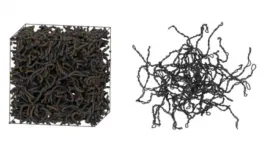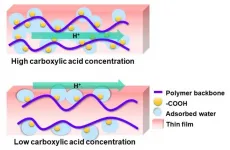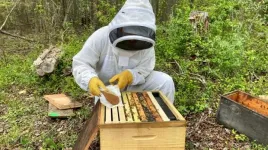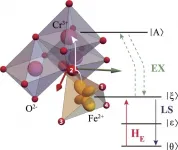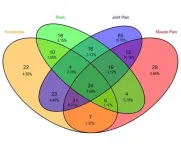(Press-News.org) While DNA is often idealised as the "molecule of life", it is also a highly sophisticated polymer that can be used for next-generation materials. Beyond the fact that it can store information, further fascinating aspects of DNA are its geometric and topological properties, such as knotting and super-coiling. Indeed, very much like a twisted telephone cord, DNA is often found coiled up inside bacteria and other cells and even knotted in viruses. Now, a collaboration of scientists from the Universities of Edinburgh, San Diego and Vienna have started to harness these properties to craft "topologically tunable" DNA-based complex fluids and soft materials with potential applications in drug delivery and tissue regeneration as published in Science Advances.
The well-known double helical shape of DNA has profound implications on its behaviour. A linear DNA molecule, that is a DNA molecule with two ends, can freely twist and turn. By contrast, joining the two ends to form a DNA circle entails that any over or under twisting of the double-helix remains "topologically locked" i.e. the extra twist cannot be removed without cutting the molecule. Over or under twists have interesting consequences for how DNA molecules arrange in space -- in particular, they coil and buckle onto themselves very much like an old telephone cord into so called supercoiled conformations (Fig. 1). The buckling of DNA relieves stress from the over/under twisting, and thereby decreases the overall size of the molecule. For this reason it is thought that supercoiling is a natural mechanism employed by cells to package their genome into tiny spaces. While the smaller size naturally leads to faster diffusion of DNA molecules in solution e.g. in water or through gel pores, because of the lower drag, this well-understood behaviour does not occur when many DNA molecules are packed and entangled like spaghetti in a bowl.
"We have performed large-scale computer simulations of dense solutions of DNA molecules with different degree of supercoiling and found several surprising results.", explains Jan Smrek from the University of Vienna, the first author of the study. "In contrast to the dilute case, the more super-coiled the DNA rings, the larger their size." Since the molecules need to avoid each other, their shapes adopt strongly asymmetric and branched conformations that occupy more volume than their non-supercoiled counterparts. Intriguingly, and contrary to expectations, "the larger DNA molecules still yield faster diffusion." The faster diffusion means that the solution has lower viscosity.
Supercoiled DNA molecules occurring naturally in bacteria are known as plasmids. In vivo, cells have special proteins called topoisomerase that can reduce the amount of supercoiling in plasmids. "Thanks to these proteins -- which can be purified and used in the lab -- we are able to control the extent of supercoiling in entangled DNA plasmids and study their dynamics using fluorescent dyes. We were amazed to discover that, indeed, DNA plasmids that were treated with topoisomerase, and hence with low supercoiling, are slower than their highly supercoiled counterparts." explains Rae Robertson Anderson, who led the experiments at the University of San Diego.
To explain the surprising faster dynamics the scientists used large scale simulations on supercomputers to quantify how entangled the molecules in solutions are. While it is known that a ringshaped polymer -- rather similar to a circular DNA plasmid -- can be threaded by another ring, meaning that the latter can pierce through the eye of the former, it was not known how this type of entanglement impacts the motion of supercoiled DNA. Thanks to the simulations, the scientists found that a high degree of supercoiling decreases the penetrable area of each molecule resulting, in turn, in fewer threadings between the plasmids and ultimately yielding a solution with lower viscosity. Nevertheless, the plasmids could still wrap around one another and constrain each others' motion without threading. Yet, the supercoiling stiffens the conformations and thereby making them less prone to bend and entwine tightly, which reduces this type of entanglement too.
Davide Michieletto from the University of Edinburgh concludes, "not only did we find these novel effects in simulations, but we also demonstrated these trends experimentally and developed a theory describing them quantitatively. By changing the supercoiling we can tune the viscosity of these complex fluids at will. We now understand much better the connection between the adaptive geometry of the molecules and the resulting material properties. This is not only exciting from the fundamental perspective, but also promises useful applications. Using dedicated enzymes, such as the topoisomerase, one can design switchable DNA-based soft materials with tunable properties."
INFORMATION:
Publication in Science Advances:
"Topological tuning of DNA mobility in entangled solutions of supercoiled plasmids", Jan Smrek, Jonathan Garamella, Rae Robertson-Anderson, Davide Michieletto, Science Advances 12 May 2021:
Vol. 7, no. 20, eabf9260, DOI: 10.1126/sciadv.abf9260
MISSOULA - In bear country, it's normal to find bruins munching down on temptations left out by humans - from a backyard apple tree to leftovers in the trash bin - but these encounters can cause trouble for humans and bears alike. One method to reduce human-bear conflicts is to secure attractants like garbage and livestock feed.
While effective when implemented, this approach requires people to change their behavior, and that makes things a little more complicated.
University of Montana researchers recently published a new study in the Journal of Wildlife Management analyzing why landowners do or don't secure attractants in bear country. ...
Ishikawa, Japan - Protons--subatomic particles with a positive electric charge--are one of the first particles to have formed after the universe began and are a constituent of every atom today out there. The movement of protons plays a key role in energy conversion processes, such as photosynthesis and respiration, in biological systems. In addition, proton conduction is an important factor for hydrogen fuel cells, which are often touted as the ideal clean energy source for the next generation.
High proton conduction observed in biomaterials such as sugar and protein derivatives is attributed to the presence of proton-donating functional groups (substituents in a molecule that governs its characteristic ...
ITHACA, N.Y. - A Cornell University-developed technology provides beekeepers, consumers and farmers with an antidote for deadly pesticides, which kill wild bees and cause beekeepers to lose around a third of their hives every year on average.
An early version of the technology ¬- which detoxified a widely-used group of insecticides called organophosphates - is described in a new study, "Pollen-Inspired Enzymatic Microparticles to Reduce Organophosphate Toxicity in Managed Pollinators," published in Nature Food. The antidote delivery method has now been adapted to effectively ...
The authors, Kirill Vasin and Mikhail Eremin, contribute to the theory of electronic and structural properties of FeCr2O4 ferrimagnet. Due to the specific quantum state and the symmetry of FeO4 fragment, it has unusual electric and magnetic properties. Below TOO~150K, it lowers the symmetry with the macroscopic deformations due to the cooperative Jahn-Teller effect. The coupling between macroscopic deformation of the crystal FeCr2O4 and its inner ions shifts was revealed. The team enhanced the microscopic crystal field theory for 3D electrons with Kleiner's correction - the effect of penetrating charges density. It allows to have better prediction of electron-deformation ...
In a paper published in NANO, the author reviewed many kinds of nanofibrous filters including the component, preparation process, and application performances to provide directional guidance for improvement of the air purification field.
Poor air quality is worldwide recognized as one of five health risks for causing adverse impacts on human health. Nanofibrous membrane is competitive to capture unclean nanoparticles since its lightweight, small diameter, high specific surface area, and easy to combine with functional additives. However, the trade-off between high filtration efficiency and low pressure drop posts challenge.
The removal mechanisms of fibrous filters to nanoparticles follow ...
How to construct the dual emission nitrogen-doped carbon dots (CDs) by a simple method? Professor Lili Ren with her collaborators proposed a new strategy to prepare such materials which were used to the detection of dopamine.
The traditional ratiometric fluorescence (FL) probe usually needs to combine different nanomaterials by chemical or physical methods and the manufacturing process is more complicated. While the dual-emission carbon dots (DECDs) can simplify the detection process. Therefore, it is of great significance to design a simple ratiometric fluorescence probe based on the DECDs for the accurate determination of DA concentration. ...
Singapore University of Technology and Design (SUTD) researchers have uncovered how the environment can impact highly sensitive quantum behaviours like localisation. Their findings, published in Chaos, could lead to future innovations in the design of superconducting materials and quantum devices, including super precise sensors.
Quantum technology, in particular quantum sensing, promises to measure and capture our world at levels of precision never before possible. Such precision has diverse applications, from speedier and more sensitive medical imaging to recording time on high-frequency ...
In the Philippines, in the early months of the COVID-19 pandemic, there occurred a supply shortage of hydroxychloroquine and methotrexate. Limited access to medication and the life changes caused from the COVID-19 pandemic may prompt patients with rheumatoid arthritis (RA) or systemic lupus erythematosus (SLE) to experience disease flares.
The researchers investigated self-reported symptoms of disease flares among patients with rheumatoid arthritis or systemic lupus erythematosus during the COVID-19 pandemic. They collected information through online surveys from 512 patients with SLE or RA. The data included ...
The Montreal Heart Institute (MHI) announces that the COLCORONA study results are published today in The Lancet Respiratory Medicine. The article, which is entitled Colchicine for community-treated patients with COVID-19 (COLCORONA): a phase 3, randomised, double-blinded, adaptive, placebo-controlled, multicentre trial, concludes that, given the lack of oral therapies available to prevent COVID-19 complications among non-hospitalized patients and the observed benefit of colchicine in patients with a PCR-confirmed diagnosis of COVID-19, this anti-inflammatory drug could be considered as a treatment for those at risk of ...
Multiple scientific studies show switching completely to vaping with high-quality products has reduced health risks compared to smoking, contrary to many consumer beliefs
Study data indicates that vaping products can provide an alternative for smokers who would not otherwise quit
Review supports the important role for vaping products in Tobacco Harm Reduction
Reinforces the importance of BAT's unique consumer-centric model and how we are reducing the health impact of our business and building A Better Tomorrow™ through our multicategory approach
To mark World Vape Day, BAT has today published a comprehensive review of the scientific evidence ...
